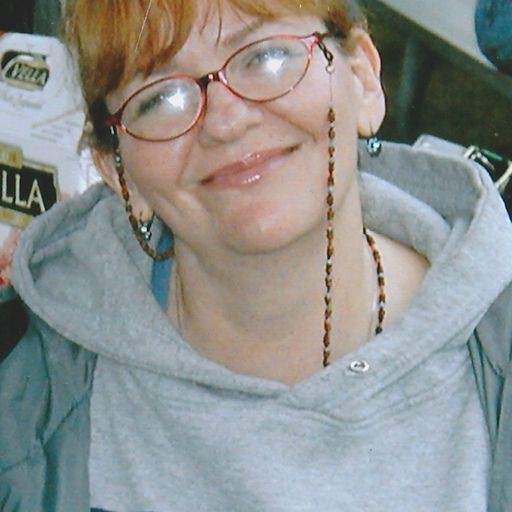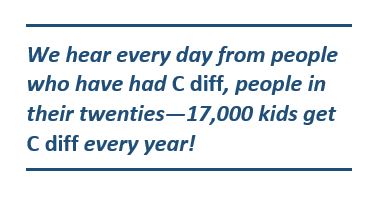Christian Lillis doesn’t have a conscious recollection of exactly the moment he and his brother Liam decided to form a nonprofit to raise awareness of the bacterial infection that led to the death of their mother. But the events that led to that decision remain clear in his mind.
Lillis’ mother, Peggy, passed away in April 2010 from complications caused by a Clostridioides difficile infection. A previously healthy 56-year-old kindergarten teacher in Brooklyn who her son says almost never took a day off, Lillis developed severe diarrhea after getting an antibiotic from her dentist on Apr 13th following a root canal. Just over a week later, after physicians had diagnosed her with a C difficile infection and performed emergency surgery to remove her colon, she died of cardiac arrest.
“We were just stunned,” Christian Lillis says when recalling what happened to his mother. “I’d never heard of C diff at that point.”
Today, Lillis is the executive director of the Peggy Lillis Foundation, using his background in fundraising and advocacy to raise awareness, educate the public, and shape policy on the bacterium that took his mother’s life. A leading cause of hospital-acquired diarrhea and the most common healthcare-associated infection, C difficile causes an estimated 500,000 infections and 29,000 deaths each year in the United States and cost the US healthcare system nearly $1 billion in 2017.
While the medical community is well aware of the damage that C difficile can cause, and its links to antibiotic use, it’s not familiar to many Americans.
Lillis believes his mother’s story, and the stories of others affected by C difficile, can help change that, and ultimately make C difficile “rare, treatable, and survivable.”
“I just feel like there’s something very relatable about my mother,” he says.
CIDRAP News recently spoke with Lillis about the Peggy Lillis Foundation, C difficile Awareness Month (November), and the importance of antibiotic stewardship. The following excerpts from the conversation have been edited for length and clarity.
CIDRAP News: Can you talk about why you started the Peggy Lillis Foundation and what its purpose is?
Christian Lillis: I just wanted to understand what happened to my mother. And [after she died] I started researching C diff and I saw that it’s killing 30,000 people a year. I’m a gay Gen-Xer. When I came out, HIV was more or less a death sentence. And then we had GMHC (Gay Men’s Health Crisis) and Act Up and other advocacy groups that kind of forced Congress and forced pharmaceutical companies to do the right thing.
So the idea of raising awareness of the disease, and getting the government to do more about it, those are sort of the seeds that we started. And because our mother was an educator, the idea that there’s something that kills that many people and no one’s heard of it was bizarre.
I had scarlet fever as a kid. My brother has dyslexia. Our mother had to do a lot of advocacy for both of us. And so we just knew that it’s what she would do.
CIDRAP News: November is C difficile Awareness Month. What do you want people to know about C difficile infection?
Lillis: Our campaign is called See C diff. So we want people to see it and to know it exists. We had some polling done last year and only about 40% of Americans have heard the term. Now that’s up from like 30% when we started back in like 2010, 2011. Hopefully our efforts have contributed to that. But compare that to something like Ebola, where 85% of Americans have heard of Ebola and yet the chances of me or you getting Ebola are [essentially] zero.
The main thing that I would like, besides them knowing that it is a sort of healthcare-associated infection, is that the primary precipitating factor is antibiotic use, current or recent. We definitely want to make that connection between C diff as a potential healthcare-associated infection and the use of antibiotics. We also like to highlight unnecessary antibiotic use. There are studies that say maybe 40% to 50% of antibiotics are medically unnecessary.
We also want people to understand that C diff can happen to anyone. So while, yes, elderly people have higher risks, how much more risky are they? You know, we hear every day from people who have had C diff, people in their twenties—17,000 kids get C diff every year!
So it really is something that can happen to anybody. And that also makes it kind of hard because you don’t have a targeted audience.
CIDRAP News: How important is it to put a human face on C difficile?
Lillis: I think it’s very important. I also think that there are downsides to that.
 Let’s talk about why it’s important. Like I said about my mother (at left), I think she’s very relatable to the average person. My mother is also white, so maybe you see her and if you’re a Black person or Asian person, you don’t resonate with her. That happens. Or if you’re a man, maybe you see her and think this is a disease of women.
Let’s talk about why it’s important. Like I said about my mother (at left), I think she’s very relatable to the average person. My mother is also white, so maybe you see her and if you’re a Black person or Asian person, you don’t resonate with her. That happens. Or if you’re a man, maybe you see her and think this is a disease of women.
But I do think what’s important about it is that, even among our advocates, getting people to talk about having virulent, explosive diarrhea for multiple days or months or years [in the case of people with recurrent C difficile], it’s very taboo. People are ashamed of it….So I think the more that people can see that other people have been through this, they survived it, they got the help that they needed…I think that part of it is very critical.
CIDRAP News: I understand that one of the major priorities of your foundation is making C diff a nationally notifiable disease. Can you explain what that means and why it’s important?
Lillis: A nationally notifiable disease is a communicable disease that the Centers for Disease Control and Prevention [CDC] mandates the reporting of by anyone who diagnoses it. HIV is a national notifiable disease. COVID swiftly became a national notifiable disease. Syphilis is nationally notifiable. These are things that are generally communicable.
What that means is, regardless of where that disease is diagnosed, and who diagnoses it, both the local health department and the CDC are notified. An example I like to use is E coli. You and I could turn on the six o’clock news and they’ll say there’s an E coli outbreak in this community, or this store had to throw out lettuce. That’s because E coli is a national notifiable disease. So if you have five people, six people in a community coming down with E coli, it’s very easy for the local health department and the CDC…to work backwards and do the disease detective stuff and really figure out what’s causing it.
C diff is one of the CDC’s top five urgent antibiotic resistance threats. But it’s the only one that isn’t nationally notifiable….In New York City right now, for example, I don’t know if one of the hospitals here is having an outbreak, or if a nursing home is having an outbreak.
I think that if we’re going to really solve the problem of this disease, actually knowing how many people get it, where it’s most prevalent, and being able to trace its cause—all of that is really critical. And I don’t think we get there unless it’s nationally notifiable.
CIDRAP News: One of the main goals of antibiotic stewardship is to promote more judicious use of antibiotics to help slow the emergence and spread of resistant bacteria. But as you know, reducing unnecessary antibiotic use can also reduce the risk of adverse events like C difficile. Would you like to see that emphasized more in discussions about antibiotic stewardship? And do you think your organization can play a role in raising awareness of the risks of unnecessary antibiotic use?
Lillis: I think it’s incredibly important that people understand that we need to change the sort of cultural social mentality we have, which is that antibiotics are risk free. This idea that even if you don’t have a bacterial infection, you just have a virus, that taking antibiotics doesn’t do any harm.
I think one of the challenges in terms of dealing with antibiotic resistance as a sort of national or international challenge or risk is that it’s very hard for people to see it in their day-to-day lives. I think we’ve seen this with climate change.
We need for people to understand that antibiotics are not risk free. I think C diff is probably the best example of the fact that when you take an antibiotic, especially an oral antibiotic, especially a broad-spectrum one, it doesn’t just kill the bacteria that’s making you sick. It kills a lot of other bacteria that you need. So I think that we have to have a real honest conversation about the risks and benefits of antimicrobials.








